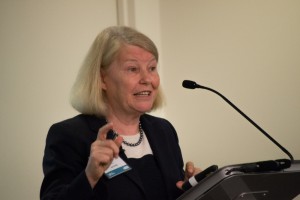On May 31-June 1, the Joan Ganz Cooney Center and New America co-hosted Fostering STEM Trajectories: at a two-day event in Washington, DC. Vivien Stewart, Senior Advisor for Education and former Vice President of Asia Society, delivered these remarks on how an international perspective on STEM education for young children may benefit our research and practices.
FIRST: Why thinking internationally ought to be part of our national research agenda in STEM and early learning.

Most American educators know that on international assessments, US students perform poorly compared with students in other industrialized countries. On OECD’s PISA assessment of 15-year-olds in 2012, the US ranked 17th in reading, 21st in science, and 26th in math. And while the US used to lead the world in high school graduation and college attendance rates, we are now 15th in the world in college completion rates. In a globalized world where high skills and the ability to innovate are critical to sustaining a high wage economy, these numbers are obviously concerning.
International research has moved beyond these kinds of simple horse race rankings between countries to trying to understand why some education systems produce better student outcomes than others; how some systems achieve both greater excellence and greater equity; and how some are moving further toward the kinds of 21st century skills and inquiry-based learning we think is needed for effective STEM education. Time doesn’t permit me to go into these findings, and you certainly need to address international research with greater nuance than does the press. Culture and context have to be taken into account: you can’t just “cut and paste” a practice from one system to another. But a growing body of international research speaks to the issue of a lack of systemness (referred to in the background paper*) as a key issue for lower-performing systems. High-performing systems, no matter what culture or world region they are in, find ways: to create a long-term education vision that is sustainable across political cycles; to align different parts of the system—such as curriculum, teacher training and assessment—so that they work together; to focus time and resources on building front-line capacity; and to involve other sectors in supporting children.
(The US is already building on the findings of international research in certain areas. For example, by looking at secondary school curriculum standards worldwide, we learned that the expectations we set our students were not high enough—which led to the development of the common core state standards in math and ELL. Similarly, research on some of the world’s best modern vocational education systems in Switzerland, Australia, and Singapore, for example, has led to major efforts in California to design modern vocational education systems based on the principles in these models. And research on the types of assessment systems used in other countries has led to increased recognition of the limitations of assessments used in the US and some experimentation with other forms. So we have already learned some valuable lessons from international research.)
SECOND: What have we learned about the teaching profession from international comparisons?
For the last six years I have been one of the organizers of an international summit on the teaching profession, which brings together ministers of education and leaders of teachers’ organizations from about 25 industrialized countries. What we’ve learned is that while some countries, including the US, have difficulty recruiting high-quality graduates into teaching and have high attrition rates from the profession, other countries have a plentiful supply of good teachers, high retention rates, and stronger student learning outcomes.
The highest performing countries have, over time, developed a comprehensive and career-long approach to the teaching profession: taking deliberate steps to attract people into the profession, raising the rigor of teacher preparation programs to equip teachers with strong subject matter skills as well as clinical experience, supporting every new teacher with a trained mentor for the first two years, and providing effective forms of professional development in school by master teachers. The latter is one of the most striking finding of the international research on the profession. Take Singapore as an example. In addition to every new teacher having a mentor, every teacher is a member of a teaching group in their school. These groups meets weekly to share the work of lesson preparation, to collectively examine student progress and diagnose student learning needs, to provide regular observation and feedback on classroom teaching, and to pilot and evaluate new approaches to issues in the school. Teachers advance up a career ladder with increasing responsibility based on their teaching skill and their effectiveness in helping other teachers. And the most senior teachers play a role across the district, researching problems, often in conjunction with university faculty, spreading best practices and innovations to other schools, and, in particular, working on improving the quality of teaching in schools that are lower-performing. These ideas are not unfamiliar in the US, where they are often known as “professional learning communities”, but in higher performing systems, these school cultures of active collaboration, classroom observation and feedback have become the norm rather than something that is an occasional or light touch thing.
In some places, technology is now being added to these systems of professional learning, for example for sharing lesson plans digitally or by using electronic means to enable master science teachers to help lead professional development for teachers in rural or disadvantaged schools where science expertise might be in shorter supply. Singapore is a highly developed model and perhaps a special case, but a number of European countries and several Canadian provinces are moving toward this kind of continuous improvement system. I believe that this kind of a continuous improvement system, with incentives to keep improving performance and collaborative reinforcement of expertise, could help to significantly lift the quality of the early childhood workforce as well.
THIRD: What are some insights about STEM learning from international research?
Most of the research I’ve been discussing has looked at the effectiveness of systems as whole rather than looking at math and science specifically. But there are some intriguing insights about STEM. For example, according to TALIS (a survey of teachers in 34 countries), compared with teachers in other countries, US teachers at the lower secondary level have much lower levels of numeracy than teachers in most industrialized countries. If our secondary teachers are relatively low on numeracy, you have to assume that our elementary and pre-K teachers are even lower. In addition, a number of high-performing countries have specialized math and science teachers at the elementary level or have a certain number of elementary teachers who have majored in math. It would be interesting to know what kinds of math skills elementary teachers in higher performing countries have. If our goal is for US children to learn to think mathematically and scientifically rather than memorize terms or algorithms, what kind of math and science skills (as well as child development and pedagogical skills) do our pre-K and elementary teachers need to possess in order to have a deep enough understanding to correct misunderstandings or differentiate instruction?
With respect to equity, we know that large numbers of American children fall behind on literacy and math by the end of third grade and that they never catch up. It would be interesting to look at some other countries that have developed different approaches to early intervention. For example, in Finland there is no special education system, but there are special teachers who begin to work with children as soon as a teacher feels they are missing a concept rather than waiting until they fail an end-of-year test before they are assigned for special help. Similarly, Singapore has systematic extra help available to students in literacy and math from the day they enter school. Are there any best practices in the US or in other countries that could reduce the number of students who are turned off math so early? Or, since many countries don’t have as marked gender differences in math and science as the US, are there best practices elsewhere that could help to promote greater interest in math among girls?
Learning goes both ways. For a long time, other countries have sent their educators to the US to learn how to emulate our inquiry-based teaching approaches. But rather than keeping them as pockets of excellence, as we do, they tend to spread them across the whole system. This is easier in those countries that have strong national or state-level authority in education. But since many education systems around the world have become highly decentralized, often down to the school level, they are also finding other mechanisms for making best practice systematic—such as the kind of continuous improvement system mentioned above and the creation of networks across schools.
Most of the studies I’ve referred to have been at the K-12 rather than the preschool level, where there has been relatively little international research beyond descriptions of system organization. Lynn Kagan is embarking on a major international study of early childhood education systems around the world, and this could be a platform for studies more focused on STEM trajectories.
The next round of PISA assessments will be released in Washington in December 2016, this time with a particular focus on science and on equity. This highly visible event could provide a good platform and starting point for an agenda on fostering STEM learning in the early years.
*A background paper on STEM in early learning was shared with participants at the convening. It will be published by the Cooney Center and New America in fall 2016.
 Vivien Stewart is Senior Advisor for Education and former Vice President of Asia Society. Over the past ten years, she developed a series of international research projects and benchmarking exchanges to share expertise between American, Asian and European education leaders. She writes extensively on education internationally. Her book, A World-Class Education, describes what the U.S. can learn from high-performing systems around the world.She was previously Director of Children, Youth and Education programs at Carnegie Corporation of New York, an education philanthropy, where she shaped agendas in early childhood and adolescent development, science education, urban school reform, and teaching as a profession. She was also a Senior Policy Advisor on Education at the United Nations. She serves on the boards of ACT, EDC, and the National Center on Education and the Economy. She received her undergraduate and graduate degrees from Oxford University.
Vivien Stewart is Senior Advisor for Education and former Vice President of Asia Society. Over the past ten years, she developed a series of international research projects and benchmarking exchanges to share expertise between American, Asian and European education leaders. She writes extensively on education internationally. Her book, A World-Class Education, describes what the U.S. can learn from high-performing systems around the world.She was previously Director of Children, Youth and Education programs at Carnegie Corporation of New York, an education philanthropy, where she shaped agendas in early childhood and adolescent development, science education, urban school reform, and teaching as a profession. She was also a Senior Policy Advisor on Education at the United Nations. She serves on the boards of ACT, EDC, and the National Center on Education and the Economy. She received her undergraduate and graduate degrees from Oxford University.

